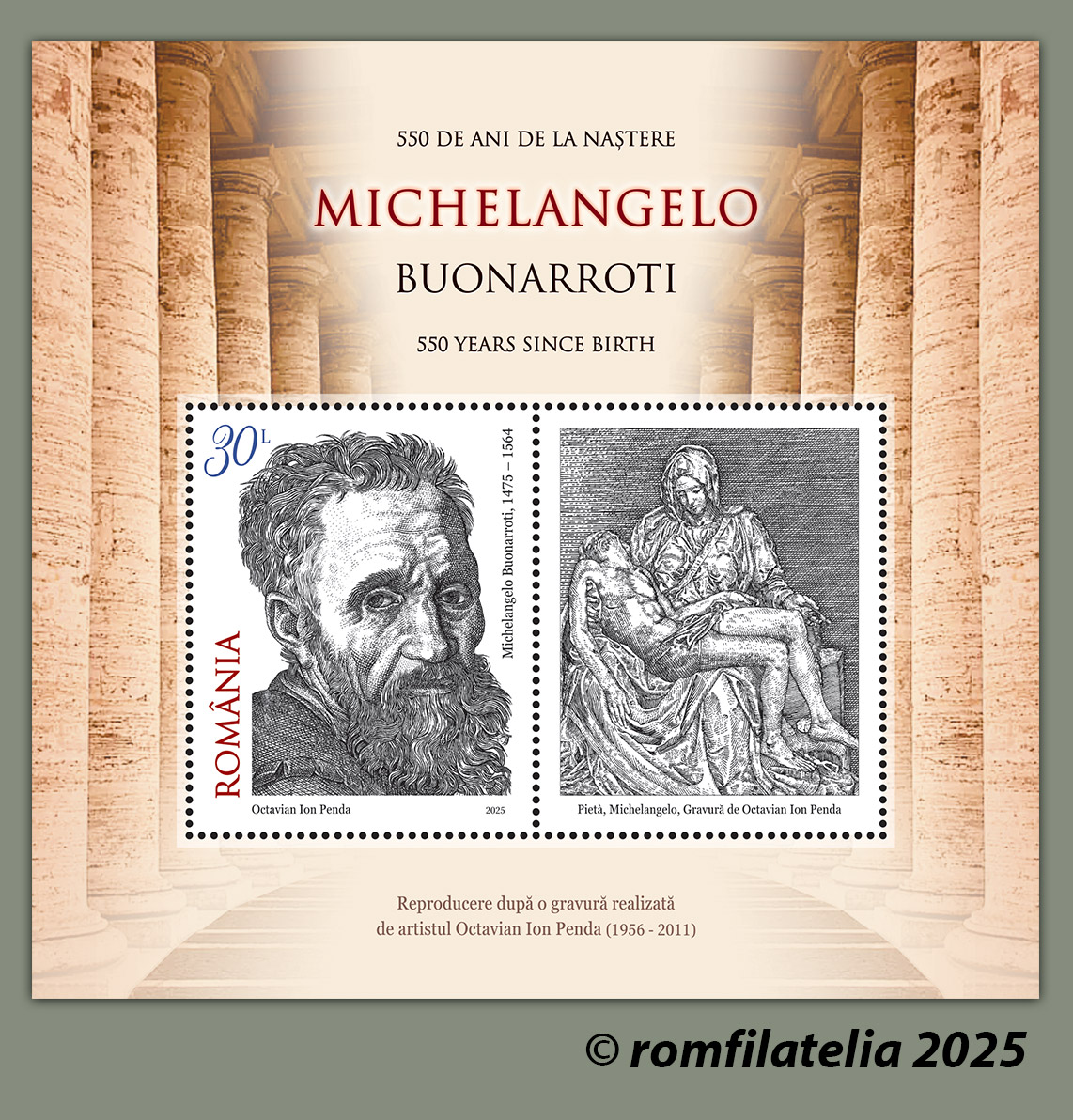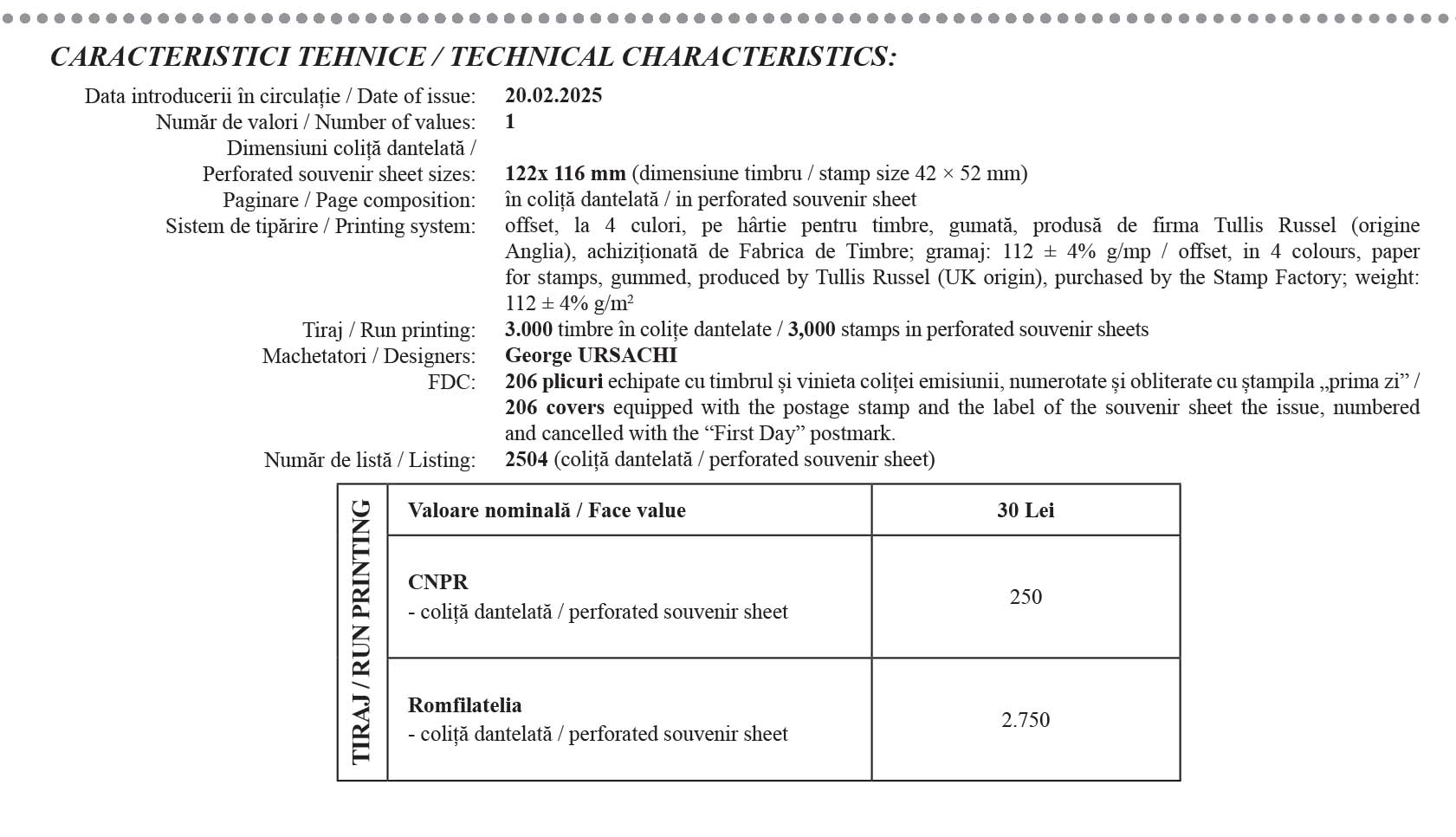 On the occasion of the anniversary of a great personality of the Italian Renaissance, Romfilatelia introduces into circulation on Thursday, February 20th, this year, the postage stamps issue ‘Michelangelo Buonarroti, 550 Years since Birth’, which includes a perforated souvenir sheet and a First Day Cover.
On the occasion of the anniversary of a great personality of the Italian Renaissance, Romfilatelia introduces into circulation on Thursday, February 20th, this year, the postage stamps issue ‘Michelangelo Buonarroti, 550 Years since Birth’, which includes a perforated souvenir sheet and a First Day Cover.
Alongside Leonardo da Vinci, Michelangelo Buonarroti was one of the remarcable figures of the most flourishing period of the Italian Renaissance. His genius is reflected in works of inestimable value in the fields of painting, drawing, and architecture.
He was born on March 6th, 1475, the second of the five sons of Lodovico di Buonarroti Simoni and Francesca di Neri del Miniato Siena.
At the age of 13, passionate about painting, he became an apprentice at the most renowned painting workshop in Florence, owned by Domenico Ghirlandaio. Also interested in sculpted works, after a year he began studying the art of ‘modelling’ stone, using as models the statues in the garden of Lorenzo de Medici, the political leader of Florence. He had the opportunity to meet prominent artists who frequented his estate, which had become an important centre of humanist culture.
After a three-year stay with the Medici family, Florence went through a period of political and social instability, which led Michelangelo to settle in Bologna, where he created three sculptures for the San Petronio Cathedral.
After a period spent in Venice, in 1496 (at the age of 21), the future great artist arrived in Rome, where he sculpted the famous Pietà for St. Peter’s Basilica. Its presentation led his contemporaries to consider him a potential genius of art. The sculpture, which depicts the Virgin Mary holding the lifeless body of Jesus, is located in St. Peter’s Basilica in the Vatican.
In 1501, upon returning to Florence, Michelangelo created the marble sculpture of the biblical figure David, standing over 4 meters tall, made from white Carrara marble. It is now housed at the Galleria dell’Accademia in Florence.
In 1505, Pope Julius II summoned him to Rome to create a mausoleum, and in 1508, he entrusted him with painting the ceiling of the Sistine Chapel (a chapel built during the papacy of Pope Sixtus IV, from whom it took its name). For four years, working alone, he created a magnificent work across an area of about 500 square meters. The effort took a toll on his health. For a time, the artist would focus on sculpture.
During the papacy of Paul III, in 1535, Michelangelo was commissioned to paint the eastern wall of the Sistine Chapel, with the theme of ‘The Last Judgment’. The work covered an area 17 meters wide and 13 meters high, and its completion was finished in 1541, after five years of work.
Among his monumental statues, created for Florence or at the request of the Vatican rulers, we can mention a few works that continue to provoke astonishment and high appreciation: Pietà (Vatican), David (Florence), the Medici Family Tomb (Florence), the Statue of Moses (San Pietro in Vincoli Church, Rome), Bacchus (Florence), and Madonna (Bruges, Belgium).
Michelangelo Buonarroti died in Rome on February 18th, 1564, at the age of 89, and is buried in a crypt at the Santa Croce Church in Florence.
The belief that guided the artist’s life is defined by his own thoughts: ‘Life is God’s gift to us. The way we live it is the gift we give to God’.
The perforated souvenir sheet reproduces two engravings by the renowned artist Octavian Ion Penda: Michelangelo, a portrait of the postage stamp with a value of Lei 30, and the sculpture Pietà, next to the postage stamp.
The First Day Cover, created as a valuable collector’s item, features the pair of the postage stamp and label from the souvenir sheet. The First Day postmark and the detailed design of the First Day Cover combine into a graphic composition that defines the universal value of an artist, a master of sculpture, painting, and architecture.



